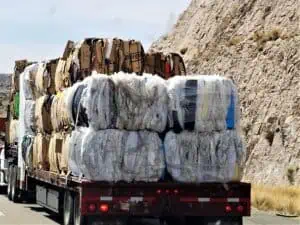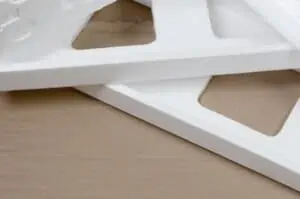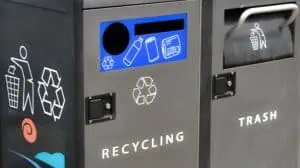Styrofoam disposal and recycling present unique challenges to companies in many industries. The lightweight and bulky nature of this material, combined with the lack of bandwidth for disposal projects, makes for a frustrating situation.
However, by understanding innovative recycling methods and partnering with top commercial recyclers, companies can take significant strides towards mitigating the environmental impact of this plastic and boosting their bottom line.
What is Polystyrene?
Polystyrene is a versatile, petroleum-based plastic that is lightweight, rigid, and an excellent insulator. It is composed of long chains of molecules derived from the monomer styrene, and these chains create a foam-like structure with a high percentage of air, giving polystyrene its unique properties. Due to its low cost, durability, and insulating capabilities, polystyrene is used in a wide range of applications, including packaging materials, disposable food containers, coffee cups, coolers, and even in construction as an insulation material.
Styrofoam is a specific type of polystyrene foam. It’s expanded through a process involving the addition of steam and pressure. This expansion creates a lightweight, spongy material that is commonly used for packaging fragile items and as disposable food containers, such as takeaway boxes and cups.
Though the terms “polystyrene” and “styrofoam” are often used interchangeably, it’s important to recognize that styrofoam is just one form of polystyrene foam.
How to Dispose of Styrofoam
Proper disposal of styrofoam is essential to prevent it from becoming a significant environmental concern and a space-waster at your facilities. Unfortunately, the lightweight and bulky nature of styrofoam makes it difficult to recycle through standard municipal recycling programs. Most recycling facilities are not equipped to handle this material. This means it’s often discarded in landfills or improperly disposed of in the environment.
Innovative recycling methods have emerged to address these challenges and mitigate the environmental impact of styrofoam. These methods focus on breaking down styrofoam into manageable components, allowing it to be effectively recycled.
Shred and Clean Material
The shredding process is a critical first step in the recycling of styrofoam or expanded polystyrene (EPS). Styrofoam waste is often bulky and lightweight, making it challenging to handle and transport efficiently; by shredding the material into small, uniform pieces, the volume of the waste is significantly reduced, making it easier to manage during the recycling process.
Specialized machines are used for this purpose. These machines are designed to crush and break down the foam into tiny beads or flakes. The shredding process not only reduces the volume of the styrofoam waste but also increases its surface area, which facilitates subsequent processing steps.
Once the styrofoam is shredded, it is essential to subject it to a thorough cleaning process. The shredded material may contain impurities such as dirt, dust, and contaminants, along with labels, adhesives, or residues from stickers. Cleaning the material is crucial to ensure the quality and purity of the recycled output.
Melt Material
After the cleaning process, the shredded styrofoam is ready for the melting stage. This stage is also known as the “densification” process, as it involves converting the expanded foam into a denser and more manageable form.
The cleaned and shredded styrofoam is fed into a specialized machine commonly known as a styrofoam densifier. Inside the densifier, the shredded styrofoam is exposed to high temperatures using a combination of heat and pressure. This causes the polystyrene beads or flakes to melt and fuse together, transforming the material into a dense, liquid state.
The melting process serves several important purposes.
- It drastically reduces the volume of the material, further compressing the already shredded foam and making it easier to store and transport.
- Melting the styrofoam turns it into a malleable and moldable substance that can be shaped into various forms.
Extrude Material
The final step in the styrofoam recycling process is extrusion. Extrusion is a well-established manufacturing process used extensively in the plastics industry. In this step, the melted polystyrene material is forced through a small opening or die to form specific shapes or profiles.
Inside the extrusion machine, the molten polystyrene is pressurized and pushed through the die, resulting in the formation of cylindrical shapes known as pellets or granules. These pellets are uniform in size and can vary in length depending on the requirements of the end product.
Extruded polystyrene pellets have numerous applications in the production of various plastic products. They can be used as raw materials for manufacturing new packaging materials, stationery items, insulation materials, and even consumer goods like toys and household items.
The Best Way to Get Rid of Polystyrene
While recycling offers a sustainable solution to styrofoam disposal, it is essential to recognize that not all recycling facilities can process this material effectively. To ensure the responsible and efficient management of polystyrene waste, collaborating with specialized recycling companies like Generated Materials Recovery becomes crucial.
Generated Materials Recovery is at the forefront of polystyrene recycling, employing state-of-the-art technologies and environmentally friendly practices. They have the expertise and resources to handle large quantities of styrofoam waste efficiently. When working with such dedicated recycling companies, businesses can rest assured that their polystyrene waste is being diverted from landfills and put to beneficial use while taking a deserved cut of the recycling profits.
Proper Styrofoam Disposal With Generated Materials Recovery
Shredding, melting, and extruding styrofoam facilitate the transformation of waste into valuable raw materials for manufacturing new products. Partnering with a specialized recycling company, Generated Materials Recovery, allows companies to responsibly manage polystyrene waste and contribute to a cleaner and more sustainable future for our planet.
Contact GMR today and get started with their Commercial & Industrial Foam Recycling Services.







